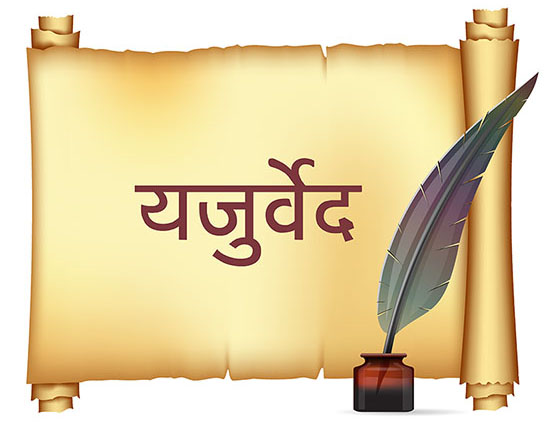 Yajurveda (यजुर्वेद) is one of the four Vedas. It is the most important Veda specifically for the sacrificial rituals which were the cornerstone of the Vedic religion. The Yajurveda is thoroughly ritual in character and contains the liturgical formulas arranged in accordance to the actual practice, as in, they are arranged exactly in the order that they were to be used for the sacrifice or यज्ञ.
Yajurveda (यजुर्वेद) is one of the four Vedas. It is the most important Veda specifically for the sacrificial rituals which were the cornerstone of the Vedic religion. The Yajurveda is thoroughly ritual in character and contains the liturgical formulas arranged in accordance to the actual practice, as in, they are arranged exactly in the order that they were to be used for the sacrifice or यज्ञ.
Function of Yajurveda
To understand the role of the Vedas, we must understand the role of the sacrifice itself. Vedic sacrifice can broadly be divided into two categories. One was that of the householder or domestic fire ceremonies (गृह्यकरमाणी) which were to be performed by one and all, rich or poor; and the other of the great sacrificial feasts. The difference was of degree. The former was to be done with only one fire at home with maybe just one priest helping the householder, who took on the role of the primary priest; whereas the latter was a grand undertaking usually only by the royals or the upper castes and the truly rich. It required three fires and a minimum of four officiating priests, who were in turn assisted by more priests. The first can be considered as individual whereas the second as a social yajña, open to the society at large.
The Yajurveda dealt directly with the actual performance of the ritual and the application of the mantras. The role of the priests and the implementation of the verses from each of the Veda show the unique positioning of the Yajurveda amongst the other Vedas. In general, the following priests were present during the sacrifice:
- The hotṛ (होतृ- the Rgvedic priest) reciting the verses (ऋच्) of the hymns in praise of the gods and inviting them;
- The udgātṛ (उद्गातृ – priest of the Sāmaveda) chanting the sāman verses of the Sāmaveda during the offering of the Soma;
- The adhvaryu (अध्वर्यु – priest of the Yajurveda) performing all the sacrificial rituals including acts and actions while muttering the yajus or the mantras of the Yajurveda;
- The brahmā (ब्रह्मा – priest of the Atharvaveda) protecting the very yajña from
In a way, the Yajurveda also established the enviable position of the priests in the Indian society of that time and no sacrifice was possible or even complete without their guidance.
Schools of Yajurveda
The Yajurveda that is available to us belongs to two śākhās or schools: –
- Black Yajurveda/Kṛśṇa (कृष्ण)/Taittiriya (तैत्तिरीय) and;
- White Yajurveda/Śukla (शुक्ल)/Vājasaneyi (वाजसनेयि).
The black Yajurveda has four recensions and the white Yajurveda has two recensions. The chief difference lies in the fact that the white saṁhitā contains only the mantra portion that is the sacrificial formulae to carry out the ritual whereas, the black saṁhitā also contains the brāhmaṇa portion that is the theological discussion related to the ritual.
Structure and Contents of the Yajurveda
The differences between the two schools are of consequence to the ritualists and theologians. However, for us to understand the general contents of the Yajurveda, a description of the Vājasaneyi Saṁhitā should suffice. It is divided into 40 chapters or adhyāyas.
The topics under discussion for the performance of the rituals are broadly the New and Full moon sacrifices (दर्श-पूर्णमास), the daily morning and evening sacrifice, the Soma sacrifices including the animal sacrifices and the important royal sacrifices of Vājapeya and Rājasūya. We also find discussions on the construction of altars of different shapes and a description of many other sacrifices. The most important portion is contained in the last chapter which makes up the ईषोवास्योपनिषद्.
In contrast, the Taittirīya Saṁhitā is divided into 7 Kāṇḍas and also begins with the New and Full moon sacrifices and includes both the verse and prose section.
Yajurveda is the Veda for all because it defines the rites and rituals of the everyday as well as the special, of the common man as well as the royalty.
References:
- Gonda, Jan. A History of Indian Literature Vol I (Vedic Literature), Wiesbaden, Otto Harrassowitz, 1975.
- Winternitz, M. A History Of Indian Literature Vol I, Calcutta, University Of Calcutta, 1927.


Add comment